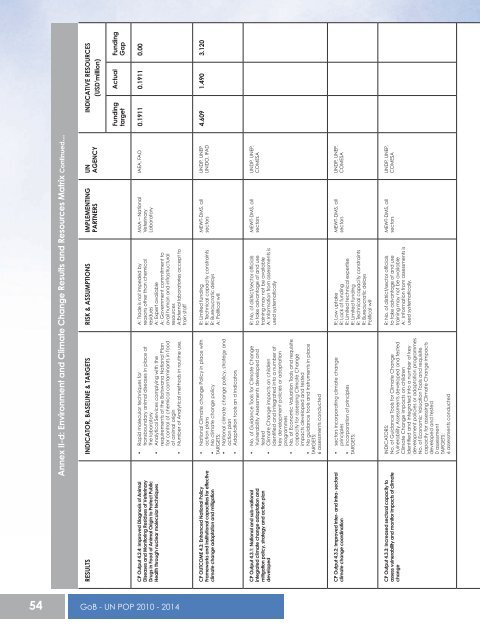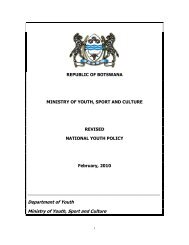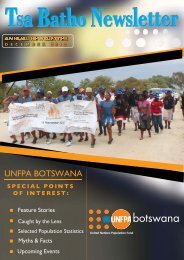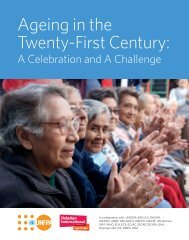GoB-UN POP 2010-2014 - UNFPA Botswana
GoB-UN POP 2010-2014 - UNFPA Botswana
GoB-UN POP 2010-2014 - UNFPA Botswana
- No tags were found...
Create successful ePaper yourself
Turn your PDF publications into a flip-book with our unique Google optimized e-Paper software.
Annex II-d: Environment and Climate Change Results and Resources Matrix Continued...RESULTS INDICATOR, BASELINE & TARGETS RISK & ASSUMPTIONS IMPLEMENTINGPARTNERS<strong>UN</strong>AGENCYINDICATIVE RESOURCES(USD’million)FundingtargetActual FundingGapCP Output 4.2.4: Improved Diagnosis of AnimalDiseases and Monitoring Residues of VeterinaryDrugs in Food of Animal Origin to Protect PublicHealth through nuclear molecular techniques• Rapid molecular techniques fortransboundary animal diseases in place atthe laboratory• Analytical Services complying with therequirements of the <strong>Botswana</strong> National Planfor control of chemical contaminants in foodof animal origin• Number of Analytical methods in routine use.A: Trade is not impeded byreasons other than chemicalresiduesA: Expert availableA: Government commitment toavail human and infrastructuralresourcesA:External laboratories accept totrain staffMoA – NationalVeterinaryLaboratoryIAEA, FAO 0.1911 0.1911 0.00CP OUTCOME 4.3: Enhanced National PolicyFrameworks and institutional capacities for effectiveclimate change adaptation and mitigation• National Climate change Policy in place withaction plans• No climate change policyTARGETS:• National climate change policy, strategy andaction plan• Adaptation tools an d indicatorsR: Limited fundingR: Technical capacity constraintsR: Bureaucratic delaysA: Political willMEWT-DMS, allsectors<strong>UN</strong>DP, <strong>UN</strong>EP<strong>UN</strong>IDO, IFAD4.609 1.490 3.120CP Output 4.3.1: National and sub-nationalintegrated climate change adaptation andmitigation policy, strategy and action plandeveloped• No. of Guidance Tools for Climate ChangeVulnerability Assessments developed andtested• Climate Change impacts on childrenidentified and integrated into a number ofkey development policies or adaptationprogrammes• No. of Economic Valuation Tools and requisitecapacity for assessing Climate Changeimpacts developed and tested• No guidance tools and instruments in placeTARGETS:6 assessments conductedR: No. of district/sector officialsto take advantage of and usetraining may not be availableA: Information from assessments isused systematicallyMEWT-DMS, allsectors<strong>UN</strong>DP, <strong>UN</strong>EP,COMESACP Output 4.3.2: Improved inter- and intra- sectoralclimate change coordination• sectors incorporating climate changeprinciples• incorporation of principlesTARGETS:R: Low uptakeR: Lack of fundingR: Limited technical expertiseR: Limited fundingR: Technical capacity constraintsR: Bureaucratic delaysPolitical willMEWT-DMS, allsectors<strong>UN</strong>DP, <strong>UN</strong>EP,COMESACP Output 4.3.3: Increased sectoral capacity toassess vulnerability and monitor impacts of climatechangeINDICATORS:No. of Guidance Tools for Climate ChangeVulnerability Assessments developed and testedClimate Change impacts on childrenidentified and integrated into a number of keydevelopment policies or adaptation programmesNo. of Economic Valuation Tools and requisitecapacity for assessing Climate Change impactsdeveloped and tested0 assessmentTARGETS:6 assessments conductedR: No. of district/sector officialsto take advantage of and usetraining may not be availableA: Information from assessments isused systematically.MEWT-DMS, allsectors<strong>UN</strong>DP, <strong>UN</strong>EP,COMESA54 <strong>GoB</strong> - <strong>UN</strong> <strong>POP</strong> <strong>2010</strong> - <strong>2014</strong>







